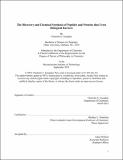The Discovery and Chemical Synthesis of Peptides and Proteins that Cross Biological Barriers
Author(s)
Farquhar, Charlotte E.
DownloadThesis PDF (29.34Mb)
Advisor
Pentelute, Bradley L.
Terms of use
Metadata
Show full item recordAbstract
The precise delivery of therapeutic agents to specific tissues or cells remains a complex task. Cell-penetrating peptides (CPPs) and proteins are used as carrier modules, tissue targeting agents, and probes to better understand disease states. In this work, we first investigate CPPs for peptide-mediated delivery of macromolecules. Despite the existence of thousands of CPP sequences, none have been approved by regulatory authorities for macromolecule delivery. Here, we demonstrate a method for in-cell penetration selection-mass spectrometry (in-cell PS-MS) to discover novel peptides from a synthetic library. These all-D, non-canonical peptides can deliver macromolecule cargo to the cytosol with high peptide stability and low toxicity. In-cell PS-MS introduces a method to discover unnatural synthetic peptides to delivery therapeutically relevant cargo into subcellular compartments.
The chromatographic enrichment of a peptide library through cation-exchange chromatography also generates novel, non-canonical peptide sequences for delivery of macromolecular cargo. We developed a method based on testing fractionated or pooled peptide libraries for the discovery of novel peptides with low toxicity, which can be modified to produce novel CPPs for oligonucleotide delivery with efficacy at nanomolar concentrations.
Cell penetrating peptides have also previously shown efficacy in crossing the blood-brain barrier (BBB), allowing a small, soluble peptide (BTP-7) to cross the BBB and target human glioblastoma (GBM). We demonstrate that conjugation of BTP-7 to camptothecin improves drug solubility in aqueous solutions, retains drug efficacy against patient-derived GBM stem cells, enhances BBB permeability, and enables therapeutic targeting to intracranial GBM, leading to higher toxicity in GBM cells compared to normal brain tissues, and ultimately prolongs survival in mice bearing intracranial xenografts of patient-derived GBM.
Dipeptide repeat proteins (DPRs), are characteristic in amyotrophic lateral sclerosis and frontotemporal dementia. Synthesis of these proteins by biological or chemical means has previously proved difficult, due to their toxicity and propensity towards aggregation. Herein we report the chemical synthesis of four DPRs using automated fast-flow peptide synthesis. Structural assays demonstrate in-vitro aggregation, especially in proline-rich DPRs. Human neuroblastoma cells cultured with arginine-rich DPRs with longer repeat lengths show reduced cell viability, thereby reproducing the cytotoxic property of endogenous DPRs. This research demonstrates the potential of automated flow synthesis for synthesizing difficult-to-access proteins and gives us new insight into the behavior of arginine-rich DPRs at the cell membrane. Collectively, this work demonstrates successful approaches to address the cellular delivery of therapeutic modalities for the future development of novel therapeutics.
Date issued
2023-09Department
Massachusetts Institute of Technology. Department of ChemistryPublisher
Massachusetts Institute of Technology